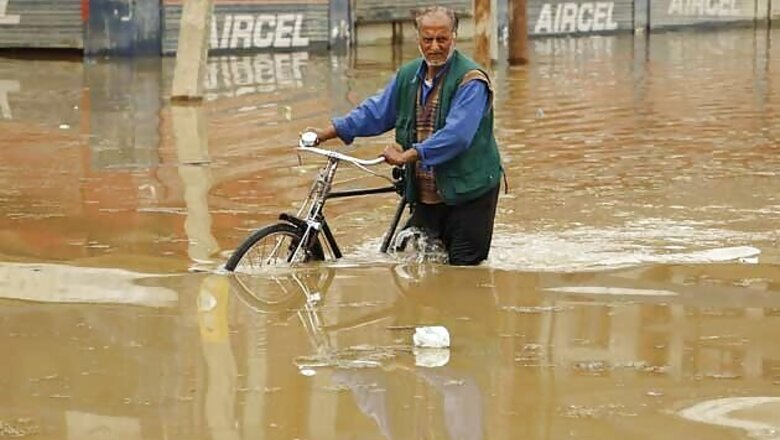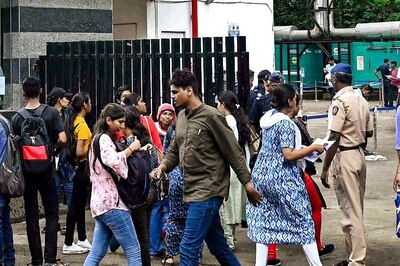
views
Srinagar: Ignorance is not always bliss. And perhaps it is the ignorance of the administration and the people of Jammu and Kashmir that a flood threat is once again looming over the valley, which in September 2014 witnessed the most ferocious and biggest floods the state has seen in over a century.
Be it the then Omar Abdullah-led government ignoring the Flood Control Department's report which in 2010 predicted that floods will hit the state in the next 5 years; or unplanned constructions over flood channel, river banks and encroachment of water bodies, we are all responsible for what is in the offing.
It is ironic that the state government, under the leadership of the then chief minister Omar Abdullah, ignored the warning of the report which clearly stated that Srinagar city awaited a major deluge and the government had no mechanism to save human lives and property.
Yet Omar pleaded that his government was caught off guard as there were no prior indications of such a catastrophe, which in one way or other badly affected the lives of every person living in the state, particularly in the Kashmir valley and in the summer capital, Srinagar.
However, contrary to his clams the report had clearly said that 150,000 cusecs of water from river Jhelum will hit Srinagar, submerging most of it. "Most parts of the valley from Khannabal in south Kashmir district of Anantnag up to Khadinyar in north Kashmir district of Baramulla are likely to be hit by the flood. The 300-km-long Srinagar-Jammu highway may be washed away, leaving Kashmir cut-off from the rest of the country. The road leading to the airport will be submerged, the report had warned.
The Flood Control Department not just predicted the floods; it had formulated a Rs 2,200-crore plan, seeking about Rs 500 crore of that immediately to put basic infrastructure in place. The then prime minister Manmohan Singh had backed the plan and promised help from the Centre, but even after five years Kashmir valley is still vulnerable to floods.
Ironically, the administration has completely failed to learn any lesson from September 2014 floods, which created havoc in Kashmir valley and destroyed property worth crores of rupees. Following floods in September, tons of slit from mountainous catchments of the rivers, including Jhelum, settled in these water bodies affecting their water carrying capacity. And on top of that major stretches of embankments of river Jhelum, which were damaged in the last floods, were not adequately braced during the past over six months to withstand another flood.
Experts say that the administration has not effectively plugged the breaches on Jhelum embankments and it has also failed to given depth to Jhelum and its tributaries, which they lost due to slit deposited during September 2014 floods.
Experts further say that Kashmir valley is at high risk of floods this year as Jhelum and its tributaries have lost water carrying capacity and velocity due to September floods.
"The administration has wasted six months and the rising water level in various water bodies has now caught them unaware. This has put the lives and property of the people living in these areas at risk," they say.
Experts say that rainfall is normal during this season in Kashmir. However, the water absorption capacity of earth has reduced due to high water table in valley, which in turn is leading to increase in water levels in rivers.
Causes:
Unplanned urbanisation, encroachments on water bodies, silt deposition and unchecked discharge of pollutants are making water bodies in Kashmir to shrink at an alarming pace, which in turn is decreasing their capacity of holding water and making the valley more vulnerable to floods.
It is ironic that despite a separate regulatory body, Lakes and Waterways Development Authority (LAWDA), massive encroachments and erection of many structures and hotels have led to the reduction in the size of Dal Lake, a world famous tourist attraction in the heart of Srinagar city. In facts people allege that LAWDA allow constructions in prohibited and non-prohibited demarcated area of Dal Lake against hefty amounts.
A PIL submitted in Jammu and Kashmir High Court in November 2014, alleged that LAWDA officials demand Rs 25,000 to Rs 50,000 for allowing constructions in non-prohibited residential areas and Rs 50,000 to Rs 1 lakh for constructions in prohibited commercial areas around the lake.
A Wikileaks cable released in 2011 about Kashmir politics was titled 'Kashmir politics as filthy as Dal Lake', which suggests how obvious the deterioration of this world famed water body had become.
Experts say that Dal Lake has shrunk from 58 square km in 1953 to 11 square km in 2015 while it has also lost 12 meters in depth. It is the same Dal Lake which in September 2014 floods racked many downtown areas in Kashmir and damaged property worth crores of rupees.
According to latest reports, even though the water level in Jhelum is below danger mark, the people living in and around Dal Lake have started to move towards safer places as water level in the lake is increasing at an alarming rate.
"The only outlet by which water can be drained out of Dal Lake is through Jhelum. But as the water level of the river is already higher than Dal Lake, the gates can't be opened. So if the rain continues, there is a possibility that the areas around Dal Lake will be inundated," official sources said.
Meanwhile, apart from reduction in size, Dal Lake has also witnessed massive pollution. Untreated sewage from hundreds of hotels, houseboats and residential houses on the bank of Dal Lake finds its way into the lake. Even though the state government is planning to shift the Dal-dwellers and rehabilitate them elsewhere, it is yet to be implemented with success.
Experts say that massive pollution of Dal Lake is directly responsible for the decrease in the depth in the lake by 12 meters.
Similarly, the 42-km long flood channel which was constructed from Padshahi Bagh in Srinagar to Wullar Lake, the largest sweet water lake in Asia, to drain out water from the valley by British engineers after one of the major floods in the history of the state in 1902, has been reduced to a small drain. The majority of the land, which used to come under this flood channel, has been illegally occupied by locals.
Dudganga nallah, which passes through Batamaloo was completely filled, totally blocking water flow. It is ironic that Srinagar Developmental Authority (SDA) shopping complexes and various commercial establishments have come up in these restricted areas.
Now, let us talk about Jhelum - the life line of Kashmir
The 240 km long Jhelum, with a catchment of thousands of kilometres, is the only drainage of Srinagar city, which is otherwise a bowl having no outtake of water. However, Jhelum is gradually turning into a garbage dump as most of the untreated waste products of the valley finds it is way to this river. It was river Jhelum which roared in September 2014 and created havoc in Kashmir valley, in a way it was saying that it will not go down without a fight.
Experts say that the depth of the river has been significantly reduced due to excessive soil erosion, which is caused by widespread deforestation in the forest areas from where the Jhelum flows.
"As the depth of the river has decreased, it has significantly reduced its water carrying capacity, the result of which was clearly visible in September 2014," they say, adding over 38 million litres of untreated waste gets discharged into river Jhelum every day.
Jammu and Kashmir known for its natural beauty has around 1230 lakes and water bodies - 415 in Kashmir, 150 in Jammu and 665 in Ladakh - but over the last two decades unplanned urbanization, deforestation and encroachments have affected most of these water bodies.
The largest freshwater lake in Asia, Wullar Lake, has shrunk more than half from its original size. The size of the lake in 2015 is 72 square km, against 190 square km two decades ago. Despite being named as the Wetland of International Importance under the 1990 Ramsar Convention, 118 square km of the land has been allegedly encroached by bribing officials.
Similarly, Hokersar, a wetland which houses 5 to 6 lakh migratory birds from around the world, has shrunk to 5 square km from its original area of 13.75 square km. Even though the wetland is situation just 15 km from Lal Chowk, it is on the verge of extension.
Mansbal and Anchar lakes too have no different story to tell, the size of these two lakes have also been reduced drastically over the last 2 decades.
It is astonishing that Dal Marg wetland, situated in Lasar Dangiwacha in north Kashmir district of Baramulla, has completely dried up. The land has now been converted into orchards, while some portions of it are used for paddy cultivation by locals.
Another wetland, Kanispora, in the same district and Chatipora wetland in Sopore, which used to attract lakhs of migratory birds until early 90's, no longer exist.
Until and unless water bodies in Kashmir are restored to their original glory and water carrying capacity of Jhelum increased, flood threat will always loom over the valley.
It is time for the administration to take cohesive measure and for the central government to come forward and provide the state funds required to make Jammu and Kashmir flood proof. The onus also lies with the people of the valley to protect their environment, act responsibly and help the state government in restoring water bodies to their original size.
(Abid Soffi is the Managing Editor of Kashmir Pioneer.)####























Comments
0 comment